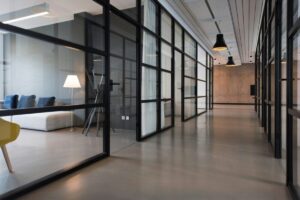Across the UK, businesses are losing over £61 billion a year in productivity due to poor natural lighting – a major concern for future economic growth.
With more employees than ever working from home, and scientific research finding that poor lighting can impact productivity by as much as 15%, a new study by home improvement specialists Eurocell has uncovered the staggering financial impact of poor natural light in many home workspaces.
The analysis shows that insufficient daylight, especially in home offices, is silently draining worker performance across almost every industry. Sectors such as real estate (£11.5bn), information and communication (£8.2bn), and professional and technical services (£7.7bn) are among the hardest hit.
Which industries are most affected?
By analysing Gross Value Added (GVA)—the measure of productivity within industries—alongside work-from-home statistics and lighting impact data, we can estimate the financial losses attributed to poor lighting per sector:
| Industry | % of remote workers | Cost of lost productivity |
| Real estate | 28.9% | £11,519,568,900 |
| Information and communication | 36.0% | £8,231,652,000 |
| Professional, scientific and technical activities | 31.1% | £7,763,166,450 |
| Construction | 31.4% | £5,967,193,200 |
| Finance and insurance | 18.8% | £4,817,772,600 |
| Admin and support services | 25.1% | £3,782,394,300 |
| Manufacturing | 12.7% | £3,745,363,350 |
| Wholesale and retail trade | 8.8% | £2,714,619,600 |
| Health and social work | 10.0% | £2,408,265,000 |
| Education | 11.2% | £1,950,093,600 |
| Public admin and defence | 12.4% | £1,824,269,400 |
| Other services | 27.8% | £1,429,017,300 |
| Transport and storage | 12.1% | £1,248,012,150 |
| Arts and entertainment | 25.2% | £1,091,134,800 |
| Agriculture, forestry and fishing | 52.4% | £907,830,000 |
| Accommodation and food services | 6.0% | £546,309,000 |
| Electricity and gas | 16.3% | £463,620,900 |
| Water and waste management | 11.2% | £436,833,600 |
| Mining | 13.8% | £330,247,800 |
| TOTAL | £61,177,363,950 |
The real estate industry sees the biggest hit to productivity from poor natural light, costing an estimated £11.5 billion a year. With nearly 29% of its workforce now working primarily from home, including agents and consultants, and over 5,000 branches closing in 2023 alone, the shift to remote work is only growing.
Other high-impact sectors include information and communication (£8.2 billion) and professional, scientific and technical services (£7.7 billion), industries that rely heavily on focused, cognitive work. Poor lighting in home offices can significantly hinder performance.
Even construction, often seen as site-based, loses £6 billion annually due to lighting-related productivity drops. Remote roles like architects, planners and project managers make up a sizable portion of its workforce.
In total, over £61 billion in productivity is lost each year in the UK due to inadequate natural light among remote and home-based workers, highlighting a critical but overlooked challenge in the modern workplace.
What can employers and home workers do to increase productivity?
There are a number of things employers can do to help encourage employees to increase their natural light intake and, in turn, boost productivity.
- Maximise natural light exposure
Encourage workspaces near windows and avoid dark corners. Even small changes in desk placement can improve focus and reduce eye strain. - Invest in larger windows or roof lanterns
Fitting roof lanterns or bigger windows can flood rooms with daylight—ideal for home offices with limited light from standard windows. - Use smart lighting to replicate daylight
When natural light isn’t an option, daylight-mimicking LEDs can help reduce fatigue and support alertness throughout the day.
Commenting on the research, Helen Godsiff, brand manager at Eurocell, said: “We all know that lighting plays an important role in how productive we are at work, but it’s shocking to see the scale of lost productivity if we aren’t working in good lighting conditions.
“As more people work remotely, it’s crucial to consider how we design our home offices with natural light in mind. Simple changes, like incorporating roof lanterns or larger windows, can make a significant difference – not just for productivity but for overall wellbeing.”
Methodology
Eurocell analysed UK GVA (Gross Value Added) data for each major UK industry sector while using workforce statistics to identify the percentage of employees working remotely within each industry.
Studies suggest that poor natural lighting can have up to a 15% impact on productivity, so this figure was applied to the number of home workers’ contributions to GVA. From this, Eurocell multiplied the number of home workers by their average GVA per employee to understand the financial losses per industry.
Data correct as of March 2025.















